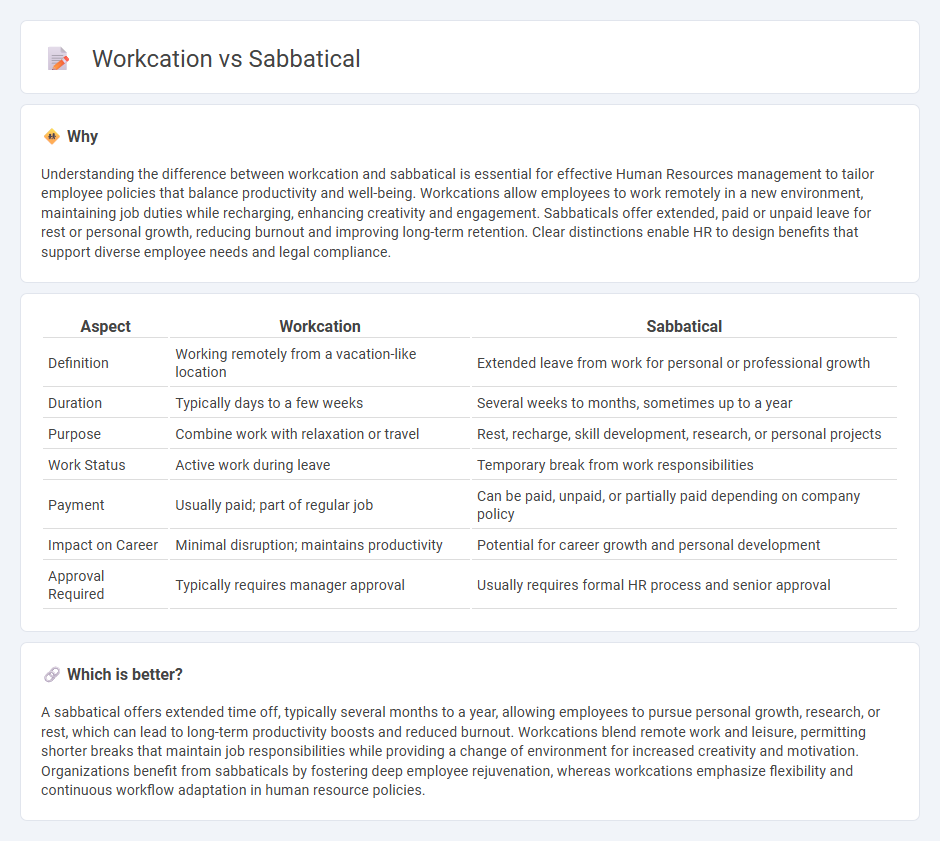
Workcation allows employees to work remotely from a different location, blending productivity with travel to enhance work-life balance and prevent burnout. Sabbaticals offer extended paid or unpaid leave for personal growth, rest, or pursuing new skills, providing a deep recharge away from daily responsibilities. Discover how organizations leverage workcations and sabbaticals to boost employee satisfaction and retention.
Why it is important
Understanding the difference between workcation and sabbatical is essential for effective Human Resources management to tailor employee policies that balance productivity and well-being. Workcations allow employees to work remotely in a new environment, maintaining job duties while recharging, enhancing creativity and engagement. Sabbaticals offer extended, paid or unpaid leave for rest or personal growth, reducing burnout and improving long-term retention. Clear distinctions enable HR to design benefits that support diverse employee needs and legal compliance.
Comparison Table
| Aspect | Workcation | Sabbatical |
|---|---|---|
| Definition | Working remotely from a vacation-like location | Extended leave from work for personal or professional growth |
| Duration | Typically days to a few weeks | Several weeks to months, sometimes up to a year |
| Purpose | Combine work with relaxation or travel | Rest, recharge, skill development, research, or personal projects |
| Work Status | Active work during leave | Temporary break from work responsibilities |
| Payment | Usually paid; part of regular job | Can be paid, unpaid, or partially paid depending on company policy |
| Impact on Career | Minimal disruption; maintains productivity | Potential for career growth and personal development |
| Approval Required | Typically requires manager approval | Usually requires formal HR process and senior approval |
Which is better?
A sabbatical offers extended time off, typically several months to a year, allowing employees to pursue personal growth, research, or rest, which can lead to long-term productivity boosts and reduced burnout. Workcations blend remote work and leisure, permitting shorter breaks that maintain job responsibilities while providing a change of environment for increased creativity and motivation. Organizations benefit from sabbaticals by fostering deep employee rejuvenation, whereas workcations emphasize flexibility and continuous workflow adaptation in human resource policies.
Connection
Workcation and sabbatical both serve as strategic human resources tools to enhance employee well-being and productivity by integrating extended breaks with work flexibility. Workcation allows employees to work remotely from a vacation location, blending leisure with professional responsibilities. Sabbaticals provide employees with prolonged, often unpaid leave to pursue personal growth or rest, ultimately reducing burnout and improving retention.
Key Terms
Leave Policy
Sabbatical leave typically involves extended time off, often unpaid or partially paid, granted to employees after several years of service for personal growth or research, reflecting a formal, structured leave policy. Workcation allows employees to work remotely from a different location while remaining fully engaged with their job responsibilities, usually supported by flexible remote work policies rather than traditional leave. Explore detailed leave policy comparisons to determine which option best aligns with your organization's goals and employee needs.
Employee Well-being
Sabbaticals provide employees with extended time off to recharge, reflect, and pursue personal growth, significantly enhancing mental health and long-term productivity. Workcations combine remote work with travel, promoting a balanced lifestyle and reducing burnout while maintaining professional responsibilities. Explore the benefits and implementation strategies to optimize employee well-being in your organization.
Remote Work
A sabbatical is an extended break from work, typically lasting several months, allowing employees to rest, travel, or pursue personal projects without job responsibilities. A workcation combines remote work with leisure travel, enabling professionals to maintain productivity while exploring new environments. Explore the benefits and challenges of both for remote work lifestyles.
Source and External Links
Sabbatical - Wikipedia - A sabbatical is an extended break from work originally based on the biblical practice of shmita, now commonly used especially in academia to allow employees a period away from routine duties to rest, recover, or focus on other projects, often with continued pay and employment status.
Sabbatical - Adobe Benefits - Adobe offers sabbaticals to eligible employees after five years of continuous service, providing extended paid leave (ranging from 4 to 6 weeks) for rest, personal projects, or volunteering, with eligibility recurring every five years.
What Is Sabbatical Leave? It's the Best Kept Secret in HR - BetterUp - A sabbatical is a paid or unpaid extended time away from work while still employed, allowing employees to rest, learn, or pursue personal goals, increasingly offered as a valuable benefit to improve retention and productivity beyond its traditional academic use.
 dowidth.com
dowidth.com